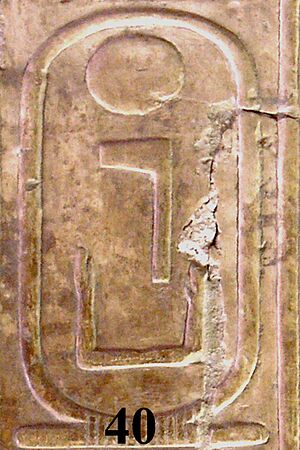Netjerkare Siptah facts for kids
Netjerkare Siptah (also called Neitiqerty Siptah) was an ancient Egyptian pharaoh. He was the seventh and possibly the last ruler of the Sixth Dynasty. Some experts think he might have been the first king of the Seventh or Eighth Dynasty instead.
As the last king of the 6th Dynasty, Netjerkare Siptah is sometimes seen as the final ruler of Egypt's Old Kingdom period. He ruled for a short time around 2200 BC. During this period, the pharaoh's power was getting weaker. At the same time, the power of local governors, called nomarchs, was growing stronger.
Even though Netjerkare Siptah was a male pharaoh, he is very likely the same person as the famous female ruler Nitocris. Her story was told by ancient historians like Herodotus and Manetho.
Quick facts for kids Netjerkare Siptah |
|
|---|---|
| Neitiqerty Siptah, Nitocris, Siptah I, Netjerkare | |

The cartouche of Netjerkare on the Abydos King List.
|
|
| Pharaoh | |
| Reign | c. 3 years, 2184–2181 BC (Sixth Dynasty or Eighth Dynasty) |
| Predecessor | Merenre Nemtyemsaf II |
| Successor | Menkare (Eighth Dynasty) |
Where Do We Find Information About Netjerkare?
The name Netjerkare is written on the 40th spot of the Abydos King List. This list of kings was made during the time of Seti I. On this list, Netjerkare is shown right after Merenre Nemtyemsaf II.
The name Netjerkare also appears on a single copper tool. We don't know exactly where this tool came from. It is now kept in the British Museum.
The other name, Neitiqerty Siptah, is found on the Turin canon. This is another ancient list of pharaohs. It is in the 5th column, 7th row of that list.
Was Netjerkare Siptah Actually Nitocris?
The Greek historian Herodotus wrote a famous book called Histories. In it, he tells a legend about an Egyptian queen named Nitocris. The story says she got revenge on a group of people who had killed her brother and husband. She gathered them for a banquet and then flooded the room by changing the course of the Nile River, drowning them all.
This same story was also told by an Egyptian priest named Manetho. He wrote a history of Egypt called Aegyptiaca around 300 BC. Manetho described Nitocris as being "braver than all the men of her time." He also said she was "the most beautiful of all women, fair-skinned with red cheeks." Manetho even claimed she built the Pyramid of Menkaure.
Herodotus does not name the murdered king. However, Manetho says Nitocris ruled right after Merenre Nemtyemsaf II. Because of this, Merenre Nemtyemsaf II is often thought to be the king who was killed.
Since the king after Merenre Nemtyemsaf II on the Abydos king list is "Netjerkare," a German Egyptologist named Ludwig Stern suggested something in 1883. He thought that Netjerkare and Nitocris might be the same person.
More recently, a Danish Egyptologist named Kim Ryholt looked into this idea. He believes that the name "Nitocris" came from a mix-up or change of the name "Netjerkare."
The Turin canon also supports this idea. This list, made during the early Ramesside period, mentions a pharaoh named Neitiqerti Siptah. Ryholt studied the papyrus fibers of the Turin canon very closely. His research suggests that the piece of papyrus with this name belongs at the end of the 6th Dynasty. This would place it right after Merenre Nemtyemsaf II.
Since Netjerkare is in the same spot on the Abydos king list as Neitiqerti Siptah is on the Turin canon, experts believe they are the same ruler. Also, the name "Siptah" is a male name. This suggests that Nitocris was actually a male pharaoh. The name "Nitocris" probably came from the name "Neitiqerti." This "Neitiqerti" might have been a changed version of "Netjerkare." Or, "Neitiqerti Siptah" could have been the pharaoh's birth name, and "Netjerkare" was his throne name.

